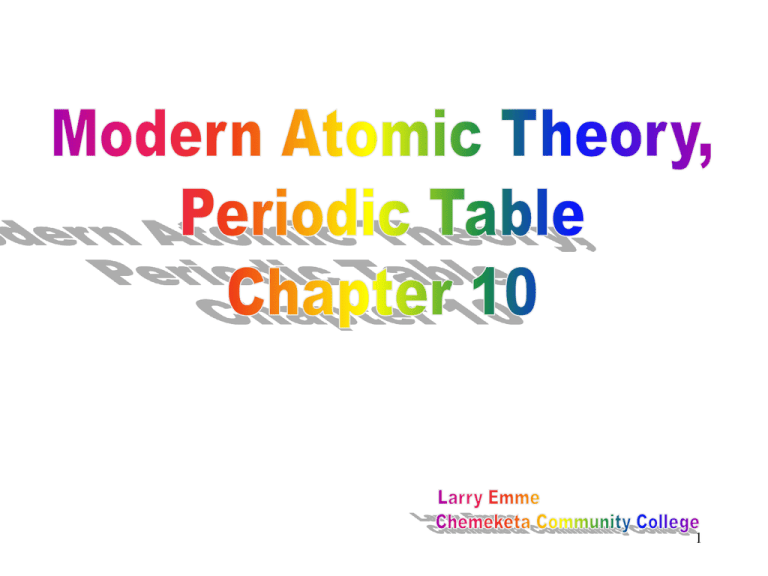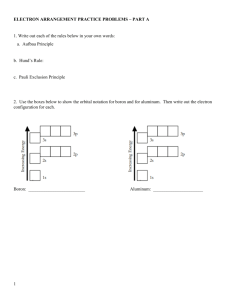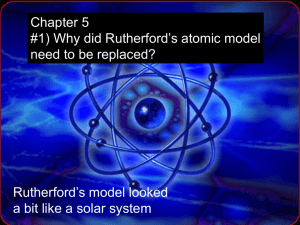Chapter 10 - faculty at Chemeketa
advertisement

1 A Brief History 2 Lucretius On the nature of the Universe (55 BC) • The light and heat of the sun; these are composed of minute atoms which, when they are shoved off, lose no time in shooting right across the interspace of air in the direction imparted by the shove. http://www.gap-system.org/~history/HistTopics/Light_1.html 3 Electromagnetic Radiation 4 5 Properties of Light • Travels in straight lines. Casts shadows • Carries energy. Heats objects it strikes. • Travels fast. No delay when turning on a light switch. • Comes in different colors. 6 Christiaan Huygens 1678 7 http://www.launc.tased.edu.au/online/sciences/physics/diffrac.html Huygens’ Principle • Throw a rock in a quiet pool, and waves appear along the surface of the water. • Huygens proposed that the wavefronts of light waves spreading out from a point source can be regarded as the overlapped crests of tiny secondary waves. • Wavefronts are made up of tinier wavefronts—this idea is called Huygens’ principle. 8 Huygens’ Principle Every point of a wavefront may be considered the source of secondary wavelets that spread out in all directions with a speed equal to the speed of propagation of the waves. 9 Huygens’ Principle • Plane waves can be generated in water by successively dipping a horizontally held straightedge into the surface • As the width of the opening is narrowed, less of the incident wave is transmitted. • The spreading of waves into the shadow region becomes more pronounced. 10 Characteristics of a Wave 11 Wavelength (λ) 12 Light has the properties of a wave. wavelength wavelength (measured from (measured from peak totrough peak) to trough) 13 Frequency (ν) 14 Frequency is the number of wavelengths that pass a particular point per second. 15 Diffraction 16 Diffraction 17 Thomas Young 18 Constructive Interference 19 Destructive Interference 20 The interference of water is a common sight. In some places, crests overlap crests; in other places, crests overlap troughs of other waves. Interference patterns of overlapping waves from two vibrating sources. Thomas Young’s original drawing of a two-source interference pattern. The dark circles represent wave crests; the white spaces between crests represent troughs. Constructive interference occurs where crests overlap crests or troughs overlap troughs. Letters C, D, E, and F mark regions of destructive interference. Interference Patterns 24 Young’s Experiment 1802 http://www.acoustics.salford.ac.uk/feschools/waves/diffract3.htm 26 Young’s Experiment 1802 27 28 Max Planck 29 • In 1901, Planck developed the quantum theory of light. • Light is not continuous. • Light is a stream of distinct units of energy called quanta. • The amount of energy on one of these units depends on the frequency. • Light is absorbed or emitted in multiples of whole quanta. • Quanta is like an atom of light called a photon 30 ROYGBIV 31 “I think it is safe to say that no one understands quantum mechanics. Do not keep saying to yourself, if you can possibly avoid it, ‘But how can it be like that?’ because you will go ‘down the drain’ into a blind alley from which nobody has yet escaped. Nobody knows how it can be like that.” Richard Feynman 1918-1988 The Manhattan Project 32 The Electromagnetic Spectrum 33 visible light X-rays Infrared light 410-7 102 Radio waves 1 10-2 10-4 Microwave Infrared 710-7 visible 104 10-8 10-10 Ultraviolet X-rays 10-12 Gamma rays Wavelength meters 34 35 The Bohr Atom 36 Niels Bohr, a Danish physicist, in 1912-1913 carried out research on the hydrogen atom 37 A young man working with Rutherford in 1911 was Niels Bohr. They created a halfway successful model of the atom called the RutherfordBohr model. They imagined a nucleus at the center with electrons orbiting around it. Twenty-five years later, Bohr described his collaboration with Rutherford... If, twenty-five years ago, I had the good fortune to give a modest contribution to this development, it was, above all, thanks to the hospitality I then, as a young man, enjoyed in the famous laboratories of England. In particular, I think with grateful emotion of the unique friendliness and straightforwardness with which Rutherford, in the midst of his unceasing creative activity, was always prepared to listen to any student behind whose youthful inexperience he perceived a serious interest. 38 • At high temperatures or voltages, elements in the gaseous state emit light of different colors. • When the light is passed through a prism or diffraction grating, a line spectrum results. 39 Sir Isaac Newton’s crucial experiment, 1672. he refracts white light with a prism, resolving it into its component colors: red, orange, yellow, green, blue and violet. 40 41 He Ne Ar Kr Xe 42 Flame test colours Ba Li Sr Na Cu K 43 Diffraction grating • Composed of a large number of close, equally spaced slits for analyzing light source • Produced by spectrometers that disperse white light into colors 44 The lenses of “rainbow” glasses are diffraction gratings. Looking through them causes light to separate into its color components. The spectral patterns seen from light sources such as fireworks and neon signs emit a distinct number of discontinuous colors and do not show all the colors of the rainbow. The spectral patterns from these light sources are the atomic spectra of elements heated in the light sources. 45 Lamps of a chandelier seen through diffraction-grating glasses. 47 Each element has its own unique set of spectral emission lines that distinguish it from other elements. These colored lines indicate that light is being emitted only at certain wavelengths. Line spectrum of hydrogen. Each line corresponds to the wavelength of the energy emitted when the electron of a hydrogen atom, which has absorbed energy, falls back to a lower principal energy level. 48 Incandescent bulb has a continuous spectrum Hydrogen Sodium Mercury The Bohr Atom 50 Electrons revolve An electron has a around the nucleus in it discrete energy when orbits thatan areorbit. located occupies at fixed distances from the nucleus. 51 The color When an electron of the fallslight from a higher emitted corresponds energy level to to a lower one of the energy lines level of the a hydrogen spectrum. quantum of energy in the form of light is emitted by the atom. 52 Different lines of the hydrogen spectrum correspond to different electron energy level shifts. 53 Light is not emitted continuously. It is emitted in discrete packets called quanta. 54 E1 E2 E3 An electron can have one of several possible energies depending on its orbit. 55 • Bohr’s calculations succeeded very well in correlating the experimentally observed spectral lines with electron energy levels for the hydrogen atom. • Bohr’s methods did not succeed for heavier atoms. • More theoretical work on atomic structure was needed. 56 57 Baseball Waves 58 • In 1924 Louis De Broglie suggested that all objects have wave properties. – De Broglie showed that the wavelength of ordinary-sized objects, such as a baseball, are too small to be observed. – For objects the size of an electron the wavelength can be detected. 59 60 In this view, the electron is thought of not as a particle located at some point in the atom but as if its mass and charge were spread out into a standing wave surrounding the atomic nucleus with an integral number of wavelengths fitting evenly into the circumferences of the orbits. 61 (a) An orbiting electron forms a standing wave only when the circumference of its orbit is equal to a whole-number multiple of the wavelength. (b) When the wave does not close in on itself in phase, it undergoes destructive interference. Hence, orbits exist only where waves close in on themselves in phase. The circumference of the innermost orbit, according to this picture, is equal to one wavelength. • The second has a circumference of two electron wavelengths. • The third orbit has a circumference of three electron wavelengths, and so forth. • The electron orbits in an atom have discrete radii because the circumferences of the orbits are whole-number multiples of the electron wavelength. • This results in a discrete energy state for each orbit. • This model explains why electrons don’t spiral closer and closer to the nucleus, causing atoms to shrink to the size of the tiny nucleus. • If each electron orbit is described by a standing wave, the circumference of the smallest orbit can be no smaller than one wavelength. – No fraction of a wavelength is possible in a circular (or elliptical) standing wave. • As long as an electron carries the momentum necessary for wave behavior, atoms don’t shrink in on themselves. Wire loop at rest. For a fixed circumference, only some wavelengths are self-reinforcing. 66 Tacoma Narrows Bridge Collapse "Gallopin' Gertie" Nov. 7, 1940 • http://www.youtube.com/watch?v=j-zczJXSxnw Davisson & Germer 1927 68 The diffraction on the left was made by a beam of x-rays passing through thin aluminum foil. The diffraction on the right was made by a beam of electrons passing through the same foil. 69 70 Baseball Waves 71 • In 1926 Erwin Schrödinger created a mathematical model that showed electrons as waves. 72 – Schröedinger’s work led to a new branch of physics called wave or quantum mechanics. – Using Schröedinger’s wave mechanics, the probability of finding an electron in a certain region around the atom can be determined. – The actual location of an electron within an atom cannot be determined. 73 • Based on wave mechanics it is clear that electrons are not revolving around the nucleus in orbits. • Instead of being located in orbits the electrons are located in orbitals. • An orbital is a region around the nucleus where there is a high probability of finding an electron. 74 Energy Levels of Electrons 75 TheAccording wave-mechanical model of the atom to Bohr the energies of also predicts discrete principal energy electrons in an atom are quantized. levels within the atom 76 As n increases, the energy of the electron increases. The first four principal energy levels of the hydrogen atom. Each level is assigned a principal quantum number n. 77 Each principal energy level is subdivided into sublevels. 78 Within sublevels the electrons are found in orbitals. An s orbital is spherical in shape (s from sharp). The spherical surface encloses a space where there is a 90% probability that the electron may be found. 79 An atomic orbital can hold a maximum of two electrons. An electron can spin in one of two possible directions represented by ↑ or ↓. The two electrons that occupy an atomic orbital must have opposite spins. This is known as the Pauli Exclusion Principal. 80 A p sublevel is made up of three orbitals. Each p orbital has two lobes. Each p orbital can hold a maximum of two electrons. A p sublevel can hold a maximum of 6 electrons. 81 pz The three p orbitals share a common center. py px The three p orbitals point in different directions. 82 A d sublevel is made up of five orbitals. The five d orbitals all point in different directions. Each d orbital can hold a maximum of two electrons. A d sublevel can hold a maximum of 10 electrons. 83 Number of Orbitals in a Sublevel 84 f Orbitals 85 Web Sites • http://web.mit.edu/3.091/www/orbs/ • http://winter.group.shef.ac.uk/orbitron/ AOs/1s/index.html 87 Distribution of Sublevels by Principal Energy Level Main energy Level (n) Maximum Sublevels (n) Maximum Maximum Orbitals Electrons (n2) (2n2) 1 1: s 12 = 1 2 2 2: s and p 22 = 4 8 3 3: s, p, and d 32 = 9 18 4 4: s, p, d, and f 42 = 16 32 88 Atomic Models John Dalton’s atom 1803 Bohr’s orbit model 1913 Thomson’s pudding model 1897 Rutherford’s nuclear model 1911 Schrödinger electron cloud model 1926 Atomic Structure of the First 18 Elements 90 To determine the electronic structures of atoms the following guidelines are used. 91 1. No more than two electrons can occupy one orbital and then only if they have opposite spin. This is the Pauli Exclusion Principle. 92 Wolfgang Ernst Pauli 93 1 s orbital 2 s orbital 2. Electrons occupy the lowest energy orbitals available. They enter a higher energy orbital only after the lower orbitals are filled. This is called the Aufbau Principle. 3. For the atoms beyond hydrogen, orbital energies vary as s<p<d<f for a given value of n. 94 4. Each orbital on a sublevel is occupied by a single electron before a second electron enters. This is Attila the Hun’s Rule (Hund’s Rule). For example, all three p orbitals must contain one electron before a second electron enters a p orbital. 95 Friedrich Hund 1896-1997 96 Attila the Hun 97 Nuclear makeup and electronic structure of each principal energy level of an atom. number of protons and of electrons number neutrons in the nucleus in each sublevel 98 Electron Configuration Using Spectroscopic Notation Number of electrons in sublevel orbitals Arrangement of electrons within their respective sublevels. 6 2p Principal Type of orbital energy level 99 Orbital Filling 100 • In the following diagrams, boxes represent orbitals. • Electrons are indicated by arrows: ↑ or ↓. – Each arrow direction represents one of the two possible electron spin states. 101 Filling the 1s Sublevel 106 H ↑ 1s1 Hydrogen has 1 electron. It will occupy the orbital of lowest energy which is the 1s. He ↑↓ 1s2 Helium has two electrons. Both helium electrons occupy the 1s orbital with opposite spins. 107 Abbreviated Electron Configurations Use the symbol of the nearest preceding noble gas to represent the electron configuration of the core electrons. Phosphorus: 1s2 2s2 2p6 3s2 3p3 Core Electrons [Ne] 3s2 3p3 Valence Electrons 108 Filling the 2s Sublevel 109 Li ↑↓ ↑ 1s 2s 1s22s1 [He]2s1 The 1s orbital is filled. Lithium’s third electron will enter the 2s orbital. Be ↑↓ ↑↓ 1s 2s 1s22s2 [He]2s2 The 2s orbital fills upon the addition of beryllium’s third and fourth electrons. 110 Filling the 2p Sublevel 111 B ↑↓ ↑↓ 1s 2s ↑ 1s22s22p1 [He]2s22p1 2p Boron has the first p electron. The three 2p orbitals have the same energy (degenerate). It does not matter which orbital fills first. C ↑↓ ↑↓ 1s 2s ↑ ↑ 1s22s22p2 [He]2s22p2 2p The second p electron of carbon enters a different p orbital than the first p electron so as to give carbon the lowest possible energy. N ↑↓ ↑↓ 1s 2s ↑ ↑ 2p ↑ 1s22s22p3 [He]2s22p3 The third p electron of nitrogen enters a different p orbital than its 112 first two p electrons to give nitrogen the lowest possible energy . O ↑↓ ↑↓ 1s 2s ↑↓ ↑ ↑ 2p 1s22s22p4 [He]2s22p4 There are four electrons in the 2p sublevel of oxygen. One of the 2p orbitals is now occupied by a second electron, which has a spin opposite that of the first electron already in the orbital. F ↑↓ ↑↓ ↑↓ ↑↓ ↑ 1s 2s 2p 1s22s22p5 [He]2s22p5 There are five electrons in the 2p sublevel of fluorine. Two of the 2p orbitals are now occupied by a second electron, which has a spin opposite that of the first electron already in the orbital. 113 Ne ↑↓ ↑↓ ↑↓ ↑↓ ↑↓ 1s 2s 2p 1s22s22p6 There are 6 electrons in the 2p sublevel of neon, which fills the sublevel. 114 Filling the 3s Sublevel 115 Na ↑↓ ↑↓ ↑↓ ↑↓ ↑↓ ↑ 1s 2s 2p 3s 1s22s22p63s1 [Ne]3s1 The 2s and 2p sublevels are filled. The next electron enters the 3s sublevel of sodium. Mg ↑↓ ↑↓ ↑↓ ↑↓ ↑↓ 1s 2s 2p ↑↓ 1s22s22p63s2 2 [Ne]3s 3s The 3s orbital fills upon the addition of magnesium’s twelfth electron. 116 117 118 Electron Structures and the Periodic Table 119 In 1869 Dimitri Mendeleev of Russia and Lothar Meyer of Germany independently published periodic arrangements of the elements based on increasing atomic masses. Mendeleev’s arrangement is the precursor to the modern periodic table. 120 Dimitri Mendeleev 121 122 Glenn Seaborg 1912-1999 123 Period numbers correspond Horizontal rows are to the highest occupied called periods. energy level. 124 Elements with similar Elements in the B groups groups in A Groups are numbered properties arenumerals. organized are designated transition are designated with Roman in groups or families. elements. representative elements. 125 Some A groups have Alkaline earth metals family names. Alkali metals (H not included) Chalcogens Halogens Noble gases 126 127 128 TheForchemical A family elements behaviortheand valence properties electron of elements configuration in a family is the same are associated in each column. with the electron configuration of its elements. 129 With the exception of helium which has a filled s orbital, the nobles gases have filled p orbitals. 130 d orbital numbers are 1 less than dthe period number orbital filling Arrangement of electrons according to sublevel being filled. 131 f orbital numbers are 2 less than the period number f orbital filling Arrangement of electrons according to sublevel being filled. 132 Period number corresponds with the highest energy level occupied by electrons in that period. 133 The Thegroup elements numbers of a family for thehave representative the same outermost elements electron are equal configuration to the total number except that of outermost the electrons electrons are inindifferent the atoms energy of the levels. group. 134 135






